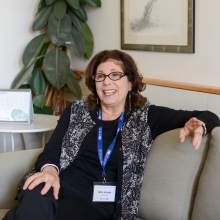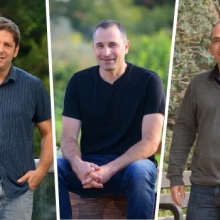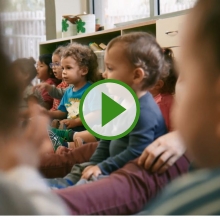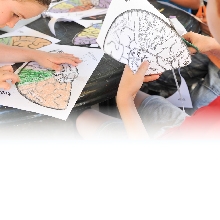Uniting the world through science
A conversation with Dr. Fabiola Gianotti, CERN’s Director-General
Q&A
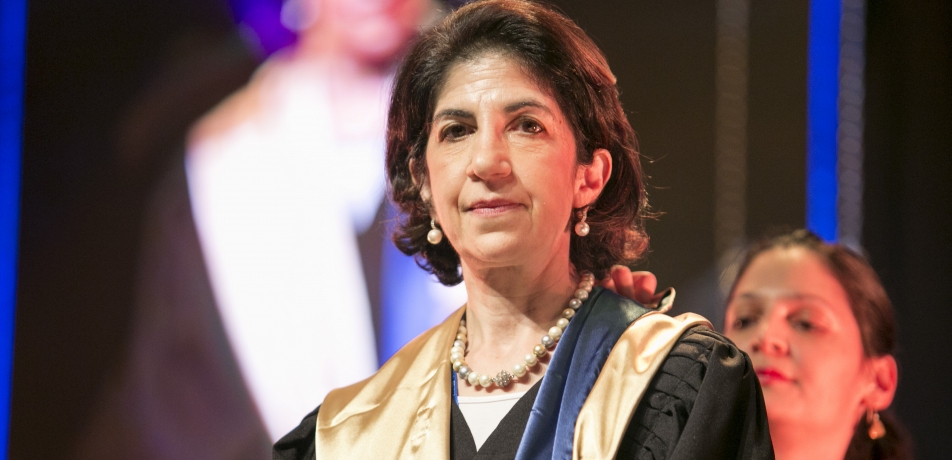
Particle physicist Dr. Fabiola Gianotti was at the center of a media frenzy when the news broke in the summer of 2012 that scientists at CERN had discovered the Higgs boson—a long-predicted piece of the cosmic puzzle that helps explain the origin of mass. It was an epic moment for CERN, which was then, as now, the world’s biggest international scientific collaboration.
She is now Director-General of CERN, the first woman to hold that position. In the mid-90s, Dr. Gianotti was part of the team at the Large Hadron Collider (LHC) that optimized the design of the electromagnetic calorimeter, part of the ATLAS detector that measures the energy of the photons and electrons produced when proton beams collide.
“It was a fantastic time,” she recalls. Today, ATLAS is a five-story-high structure, capable of capturing data derived from over a billion particle collisions per second, and transferring this data instantly to a global network of high-powered computers for analysis.
“We chose the technology and materials, designed the detector, performed tests with prototypes, and ran simulations,” she continues. “It was our job to present our dream design to the engineers, and it was the engineers’ job to say ‘you’re crazy!’ The compromise we achieved—between what was sketched out in theory and what eventually became the nuts and bolts of ATLAS and the LHC—led to the discovery of the Higgs boson.”
Dr. Gianotti worked side-by-side with Weizmann scientists who contributed research critical to the success of ATLAS, something that made her first-ever trip to campus in November, to receive her honorary doctorate, particularly meaningful.
A native of Italy, Dr. Gianotti’s relationship with CERN began when she was a doctoral student at the University of Milan. After completing a postdoctoral fellowship on site, she joined CERN’s research staff, and was on hand to see the first high-energy proton beams accelerated through the LHC in 2010—something that she describes as a very emotional achievement.
“I had worked on an experiment involving CERN’s smaller accelerator, the Super Proton Synchrotron,” she says. “But with the LHC, we achieved much higher energies. LHC experiments involving ATLAS and CMS [another general-purpose detector] allowed us to break down protons into much smaller pieces. Particles never seen before, like the Higgs boson, could now be produced and observed. Among other things, these findings provided insight into the evolution of the universe.”
Dream big
In 2009, Dr. Gianotti was named spokesperson (project leader) for the ATLAS experiment, a position previously held by Prof. Peter Jenni, a longtime friend and mentor at CERN who received an honorary doctorate from the Weizmann Institute last year. Dr. Gianotti credits Prof. Jenni with inspiring her to dream big while remaining pragmatic, and providing her with a brilliant example of how to get scientists from all over the world to work together.
“Since its discovery in 2012, we have learned a lot about the Higgs boson,” she says. “But we need to improve the precision of our measurements and continue to address other outstanding questions in particle physics. The LHC will operate until 2037, but it’s not too early to think about our next steps.”
Dr. Gianotti will be deeply involved in the update of the European strategy for particle physics, a community effort that will articulate unified goals to guide the field into the future. As she sees it, this is an effort of global significance, and not just for science.
“We live in a fractured world. But at CERN, over 17,000 scientists from 22 member states and other countries, representing more than 110 nationalities, some coming from countries in conflict, work together, animated by the same passion for knowledge,” she says. “This is one of the things that gives me the most pride—demonstrating what humanity can achieve when we set aside our differences and focus on the common good.”



